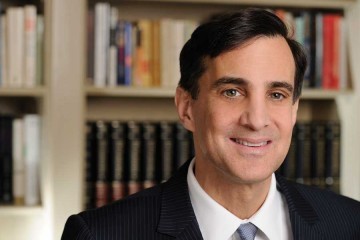Johns Hopkins University President Ronald J. Daniels emphasizes the "critical importance" of continued investment in scientific research and development in a new video released today by The Science Coalition.
"One of the things that has been so remarkable about this country, the genius of this country, has been its willingness to invest where other countries have not, in basic R&D, and recognizing that that investment will have a whole host of consequences that will improve [life in] this country … in ways we can't possibly imagine," Daniels says in the video, part of the group's Science 2034 project.
Science 2034 was launched by The Science Coalition, which advocates for strengthening federal support for basic scientific and engineering research. The series, which celebrates the group's 20th anniversary, looks ahead 20 years at the possibilities of science in the future and how it might change our lives and the world.
The decline in NIH funding over the past decade has ramifications for all scientific researchers, Daniels notes. But America's young scientists have been disproportionately affected, are increasingly missing out on research dollars, and are exiting the academic biomedical workforce, a brain drain that poses grave risks for the future of science.
"This has simply catastrophic consequences for the country and for, indeed, the globe" says Daniels, who has authored commentaries on the topic in The Wall Street Journal and the journal Proceedings of the National Academy of Sciences. "When you look at where the great revolutions have been made, where paradigms have been shifted, where science has had its most discernible effect, … it is typically related to the work of brave young men and women."
The number of principal investigators with a leading NIH grant who are 36 years old or younger dropped from 18 percent in 1983 to 3 percent in 2010, Daniels wrote in PNAS. Meanwhile, the average age at which a scientist with a medical degree gets the first of these grants has risen from just under 38 years old in 1980 to more than 45 in 2013.
While recent legislative efforts—including House passage of the 21st Century Cures Act in July—could lead to increases in NIH funding, there are a number of legislative hurdles to overcome before additional resources flow to campus.
In an effort to mitigate the impact of funding declines, Johns Hopkins—which has led the U.S. in higher education research spending for 35 consecutive years, according to a National Science Foundation report—this year created two new awards programs that together will provide an additional $15 million to support innovative faculty-led research over the next three years. Thirty-seven early career scholars recently received Catalyst Awards, and another 23 cross-divisional faculty teams received Discovery Awards.
"One word of advice I have for young people is, stay the course," says Daniels, who will speak about research funding today at an American Association of Medical Colleges meeting in Baltimore. "You came to this field because you were passionate. You felt that your life would find meaning and you would have an impact if you committed yourself to scientific inquiry, and you've got to be true to yourself. … It's just so important that we don't lose these scholars of promise from our field."
Posted in University News
Tagged president ron daniels, research funding, catalyst awards, discovery awards










